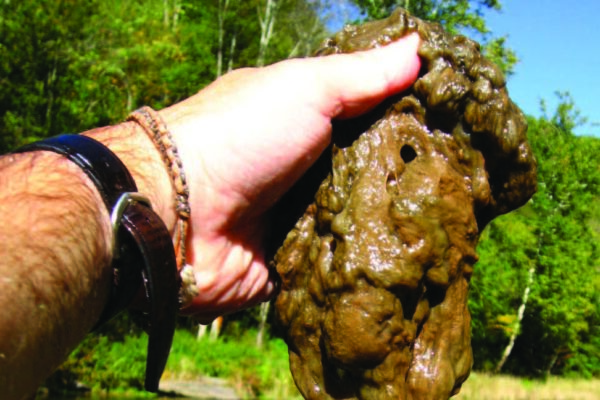Didymo

Species at a Glance
Didymo (Didymosphenia geminata), commonly referred to as “rock snot”, is a species of freshwater diatom native to cool-water regions of northern Europe and North America. Didymo forms massive blooms that blanket streambeds, choke streams and rivers, and threaten aquatic ecosystems.
Species Description
Didymo is a large diatom, which is a type of single-celled algae. Although it is microscopic, didymo can form dense colonies called algal blooms that can be seen with the naked eye. Young colonies look like raised pimples on the surfaces of river rocks; however, they can grow and elongate to form long stalks. The extracellular stalk material forms thick nuisance mats that appear as strands of toilet paper or fiberglass, with the rough texture of wet wool. Unlike most other algae, didymo does not feel slimy, although it appears to be. Because the stalk material lacks chlorophyll, blooms appear a pale yellowish brown to white color, but never green.
Native & Introduced Ranges
Didymo is thought to be native to the northern regions of Europe, Asia, and other cool water areas in the northern hemisphere. In recent years, it has exhibited a much greater tolerance for different water chemistry conditions, and has expanded to diverse areas including British Columbia, Canada, New Zealand, and southeastern and western United States. The first report of didymo blooms in the northeastern United States was in June 2007 from the northern reaches of the Connecticut River and the White River in Vermont. In October 2007, blooms were discovered where the east and west branches of the upper Delaware River meet along the New York and Pennsylvania border. In Pennsylvania, didymo has been discovered primarily in north central and western counties.
Biology & Spread
Until recently, didymo was restricted to colder, alpine lakes; however, blooms are now occurring in streams and rivers at an increasing rate. Anglers, kayakers, canoeists, and boaters can unknowingly spread this microscopic alga, which can cling to fishing gear, waders, boots, and boats. Studies indicate that didymo can survive outside of a stream in a cool, dark, damp environment for at least 40 days, and only one cell is needed for it to spread.
Habitat
Didymo is both epilithic (attaching to stones) and epiphytic (attaching to plants) and can thrive in a wide range of physical and chemical conditions within lakes and rivers. While it prefers relatively shallow, clear, moderately-flowing, and nutrient-poor streams and rivers with rocky substrates, didymo is exhibiting a much greater tolerance for water nutrient and flow conditions than expected. Nuisance blooms are only known to occur in flowing water.
Impacts
Threat to Biodiversity
During nuisance blooms, didymo cells can create large amounts of stalk material that form thick mats of grey, white, or brown cottony material on the bottom of rivers and streams. These mats, which can be over 20 cm thick, are capable of engulfing a stream bottom, covering substrates, and smothering native species of plants, insects, mollusks, and algae, reducing habitat and food availability for aquatic insects and fish. While aesthetically unappealing, didymo does not appear to be a threat to human health.
Economic Costs
Didymo’s expanding range has the potential to impact fisheries, tourism, and hydropower. It thrives in canal systems, impacting communities that rely on these systems to transport water for hydropower generation, aquaculture, and human consumption. Didymo is also a threat to tourism, as it is unsightly and is frequently mistaken for raw sewage. In Pennsylvania, didymo has the potential to impact trout fisheries by altering the aquatic invertebrate food base, as well as altering water quality parameters that could be harmful to trout.
Prevention & Control
The only sure way to control the spread of didymo is to check, clean, and dry. Always check your equipment and boots before leaving a stream or river. Remove any obvious clumps of algae, look for hidden clumps, and leave them at the affected site. If algae is found on gear or equipment after you return home, do not wash down drains; instead dispose of all material in the trash. Soak and scrub all non-absorbent equipment for at least one minute in either hot water (140°F or 60°C), or a 2-percent solution of household bleach, a 5-percent solution of salt, antiseptic hand cleaner, or dishwashing detergent. Absorbent items, such as felt-soled waders, require longer soaking times to allow saturation; soak for at least 40 minutes in hot water above 140°F (60°C), or 30 minutes if the hot water is mixed with a 5-percent dishwashing detergent kept above 115°F (46° C). .
If cleaning is not practical, allow equipment to dry completely, then wait an additional 48 hours before allowing contact in other water bodies. Check thick, absorbent items closely to insure they are dry throughout. Equipment and gear can also be placed in a freezer until all moisture is frozen solid.
References:
- Elwell, Leah.,Spaulding, Sara. 2007. Increase in nuisance blooms and geographic expansion of the freshwater diatom Didymosphenia geminata.White paper.
- Kilroy, Cathy., et al. 2005. Ecological Studies on Didymosphenia geminata. Biosecurity New Zealand. Pennsylvania Fish and Boat Commission. 2012. Do you know about Didymo? Website.



